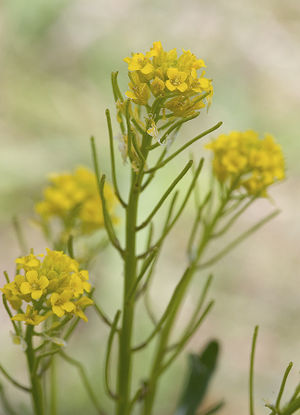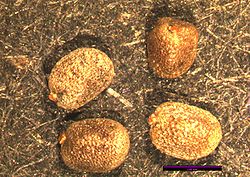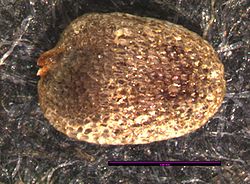Barbarea orthoceras
- Scientific Name: Barbarea orthoceras
- Family: Brassicaceae
- Common Names: American wintercress rocket, yellow rocket
- Synonyms/Misapplications: Barbarea americana, Barbarea stricta, Campe orthoceras
- Codon: BARORT
Contents
Taxonomy
| Scientific classification | |
|---|---|
| Kingdom: | Plantae |
| Subkingdom: | Viridiplantae |
| Phylum: | Tracheophyta |
| Subphylum: | Spermatophytina |
| Class: | Magnoliopsida |
| Order: | Brassicales |
| Family: | Brassicaceae |
| Genus: | Barbarea W. T. Aiton |
| Species: | Barbarea orthoceras Ledeb. |
| Synonyms | |
| |
Description
Erect, mostly glabrous biennial herb growing from a taproot with yellow racemes, to 6 dm tall.[2] Basal and cauline leaves lyrate-pinnatifid, lobes 1-4 on each side,[3] margins entire to crenate.[2] Cauline leaves alternate, auriculate-clasping.[3] Racemes ebractate.[4] Flowers bi-radially symmetrical, 4-merous; stamens 6, tetradynamous;[5] ovary superior, 2-carpellate, becoming linear, 1-nerved,[4] 4-angled siliques, 1.5-5 cm long.[5]
Bloom Period
April-July[2]
Distribution
Throughout Washington. From Alaska to California and across northern North America.[5]
Habitat
Lower elevation meadows, stream banks and forests.[5]Hardy to zone 0,[6] preferring moist, well-drained soil.[7]
Uses
First Nations use rosettes of the dark green shiny leaves can be cooked or eaten raw in a salad.[8]
Propagation
Sow seeds in situ in early spring to early summer.Succeeds in sun or shade in a moist well-drained soil. [9]
Seed
Seed sample from: 2011
Average Measurement: 1.6 x 1.1 x 0.8
Measurement Range: L: 1.4 - 1.9, W: 1 - 1.3, D: 0.7 - 1
Color: Hilum reddish and pinched looking. Seed is brownish red.
Surface:Some concave pitting on seed surface. Entire seed is covered with a net veined pattern giving it a scaly appearance. Seed is shiny.
Latitudinal Cross Section: elliptical ![]()
Longitudinal Cross Section: elliptical ![]()
Basic Explanations and Assumptions:
The dimensions for the seeds are length x width x depth. The location of the hilum is used as the base of the seed, and the length is measured from hilum to the opposite apex. Where a style is present, the length is measured from the hilum to the bottom of the style. Width is measured at a right angle to the length at the widest part. Depth is measured at a right angle to the intersection of height and width lines.
Measurements included are the mean average for each measurement of ten separate seeds.
All measurements in millimeters unless otherwise noted.
Photo Gallery
References
- ↑ Integrated Taxonomic Information System. Retrieved from https://www.itis.gov/servlet/SingleRpt/SingleRpt?search_topic=TSN&search_value=22740
- ↑ 2.0 2.1 2.2 WTU Herbarium, Burke Museum, & University of Washington. Retrieved from http://biology.burke.washington.edu/herbarium/imagecollection/taxon.php?Taxon=Barbarea%20vulgaris
- ↑ 3.0 3.1 Flora of North America. Retrieved from http://dev.floranorthamerica.org/Barbarea_orthoceras
- ↑ 4.0 4.1 Hitchcock, C. L., Cronquist, A., Giblin, D., & Legler, B. et al. (2018). Flora of the Pacific Northwest: an illustrated manual. Seattle: University of Washington Press. p. 284.
- ↑ 5.0 5.1 5.2 5.3 WTU Herbarium, Burke Museum, & University of Washington. Retrieved from http://biology.burke.washington.edu/herbarium/imagecollection/browse.php?Genus=Barbarea
- ↑ USDA Plants Database. Retrieved from https://plants.usda.gov/core/profile?symbol=baor
- ↑ Plants for a Future. Retrieved from https://pfaf.org/User/plant.aspx?LatinName=Barbarea+vulgaris
- ↑ Native American Ethnobotany Database. Retrieved from http://naeb.brit.org/uses/7013/
- ↑ Huxley. A. The New RHS Dictionary of Gardening. (1992). MacMillan Press.




